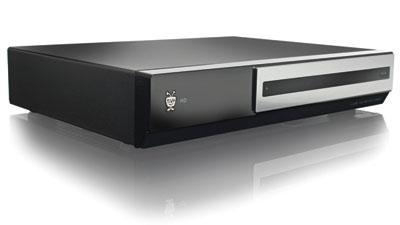TiVo HD DVR

Now that cable operators are required to separate access and security from the tuner(s) in new set-top boxes, you have the opportunity to buy a digital video recorder that's potentially more stylish and capable than the one you might be leasing. The new TiVo HD DVR is timed to appeal to TV addicts who are either dissatisfied with their leased box or have heard about TiVo and are curious to see what all the fuss is about.
TiVo HD is also timed to the new Multistream CableCARD (M-Card), the next-generation access card that supports multiple tuners from a single card. You rent it from your cable company at a fraction of the cost of a leased DVR. But like its more expensive predecessor, the award-winning TiVo Series 3 Digital Media Recorder I reviewed last year, TiVo HD has two CableCARD slots in case the M-Card isn't available. Either way, you'll be able to record two programs at once, including premium channels, and they can both be in high definition.
TiVo HD is similar to the Series 3, the big difference being the price - $300 instead of $800 list. Though TiVo HD retains the Series 3's essential features, it doesn't display program titles or time on the front panel. Also, storage capacity has been reduced from 250 to 160 gigabytes, THX certification is gone, and the original non-backlit TiVo remote is included instead of the premium Series 3 version.
SETUP Included in the box are composite-video/stereo-audio and component-video cables and, in case you don't have broadband access, a phone cord. (TiVo still builds in a dial-up modem for antediluvian viewers who download guide information and software updates the old-fashioned way.) I supplied my own HDMI cable. There's also an optical digital audio output for connecting to a surround sound system. The TiVo Wireless G Network Adapter ($60) plugs into one of two USB ports. I attached my own Ethernet cable to the RJ45 jack instead.
It takes a few minutes for TiVo to boot up, but the onscreen prompts guide you through the setup, including video resolution. I chose the fixed 720p video output option to match my two-year-old plasma TV, though the TiVo HD does 1080i as well for 1080i/p displays. TiVo's onscreen list of TV manufacturers gave me the code I needed to punch in on the remote so I could control the TV's power, volume, and designated input. In setting up the program guide, I was able to combine over-the-air analog and DTV channels and cable channels, but actually receiving all my cable channels required a visit from a cable installer packing CableCARDs.
TiVo HD's CARD slots are located under a lid on the front. Time Warner Cable of New York City wouldn't have M-Cards available until the end of my review cycle, so the installer slid a regular CableCARD into the first slot. He called in a series of numbers that appeared on the TV screen to activate service. Channels tuned in as they should. But things didn't go as smoothly with the second slot. In trying three different cards, the picture on the majority of channels was either black or consisted entirely of colored mosaics. After several hours of trying, the cable guy and I concluded it was probably a TiVo problem. I had him leave cards in both slots. During the next month the TiVo downloaded several revisions of its operating system with varying degrees of success - unfortunately, a not uncommon experience for reviewers playing with sophisticated, just-released products. It took a while, but eventually we got it all working. Buyers should be able to avoid similar trouble by making sure to download the latest TiVo firmware version immediately after initial installation.
- Log in or register to post comments





























































